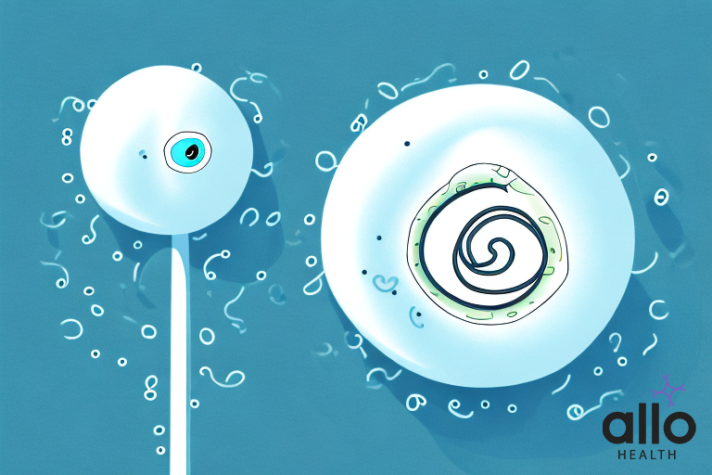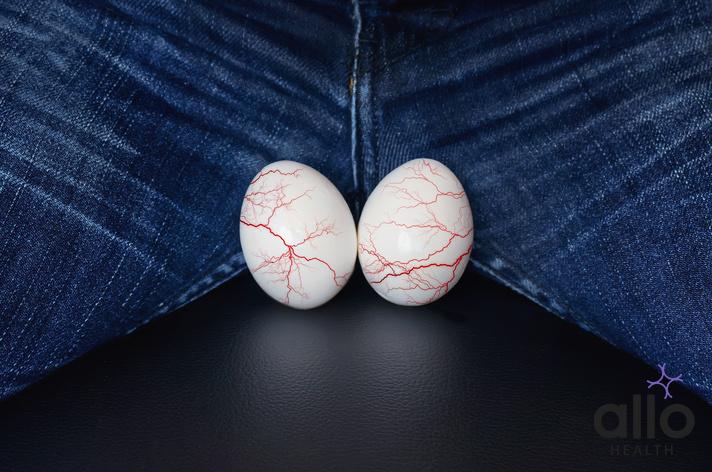Do Testicles Shrink After Ejaculation?

Allo Health is dedicated to personalized well-being, offering support and trusted information tailored to individual health goals. The platform emphasizes human-generated content, led by a distinguished medical team of experts, including physicians and sexual health specialists. Their commitment to credibility involves rigorous fact-checking, authoritative research, and continuous updates to ensure accurate, up-to-date information. Allo Health's unique approach goes beyond conventional platforms, providing expert-led insights and a continuous commitment to excellence, with user feedback playing a crucial role in shaping the platform's authoritative voice.

Dr Saachi has done her MBBS from Kasturba Medical College, Manipal. She has worked as a research observer in Dept. of microbiology; she also has a keen interest in the human psyche, relationships and Sexual health.
Why This Was Upated?
Our experts continually monitor the health and wellness space, and we update our articles when new information became available.
Updated on 22 June, 2024
- Article was updated as part of our commitment to diversity, equity, and inclusion.

"The following blog article provides general information and insights on various topics. However, it is important to note that the information presented is not intended as professional advice in any specific field or area. The content of this blog is for general educational and informational purposes only.
Book consultation
The content should not be interpreted as endorsement, recommendation, or guarantee of any product, service, or information mentioned. Readers are solely responsible for the decisions and actions they take based on the information provided in this blog. It is essential to exercise individual judgment, critical thinking, and personal responsibility when applying or implementing any information or suggestions discussed in the blog."
If you’re a man who is sexually active, there’s a good chance you have wondered about testicle shrinkage after ejaculation. Some people say that this is a normal occurrence, while others suggest that it can be a sign of an underlying health concern. In this article, we’ll explore the facts surrounding this topic to find out what’s really going on.
What Are Testicles?
Testicles, also known as testes, are a pair of male reproductive organs that play a crucial role in the production of sperm and the secretion of hormones, particularly testosterone. Here are the key details about testicles:
- Location and External Appearance:
- Testicles are situated within the scrotum, a pouch of skin and muscle that hangs below the penis.
- They are typically oval-shaped and have a slightly wrinkled surface.
- The scrotum helps regulate the temperature of the testicles, which is essential for proper sperm production.
- Internal Structure:
- Each testicle is composed of several structures, including seminiferous tubules, where sperm are produced, and interstitial cells (Leydig cells), which produce testosterone.
- Sperm Production:
- The primary function of the testicles is to produce sperm through a process called spermatogenesis.
- Sperm production begins at puberty and continues throughout a man’s life.
- Sperm are then transported from the testicles through a network of tubes, eventually reaching the epididymis for maturation and storage.
- Hormone Production:
- In addition to sperm production, the testicles secrete hormones, most notably testosterone.
- Testosterone is a crucial male sex hormone that plays a vital role in the development of male reproductive tissues, including the testicles themselves, as well as the development of secondary sexual characteristics like facial hair, deepening of the voice, and increased muscle mass.
- Regulation of Functions:
- The production of sperm and hormones in the testicles is regulated by the pituitary gland, a small gland at the base of the brain.
- The pituitary gland releases hormones like luteinizing hormone (LH) and follicle-stimulating hormone (FSH), which stimulate the testicles to produce testosterone and support spermatogenesis.
- Role in Reproduction:
- Testicles are crucial for male fertility, as sperm produced in the testicles are necessary for fertilizing a female egg during sexual reproduction.
- Vulnerability to Injury:
- The testicles are sensitive and can be vulnerable to injury. The scrotum acts as a protective covering, but trauma or injury can still occur.
Understanding the anatomy and function of the testicles is essential for overall reproductive health and fertility in males. Regular self-examinations and medical check-ups can help identify any abnormalities or potential concerns early on.
Causes Of Testicles Shrinkage
Testicle shrinkage, clinically referred to as testicular atrophy, can be caused by various factors. If you experience testicular shrinkage or have concerns about your reproductive health, you should consult with a healthcare professional for an accurate diagnosis and appropriate guidance. Here are some potential causes of testicle shrinkage:
- Age: Testicles naturally undergo some degree of atrophy with age, particularly after the age of 50. This is a normal part of the aging process, and the rate of testosterone production may decrease.
- Hormonal Imbalances: Hormonal imbalances, particularly low testosterone levels, can contribute to testicular atrophy. Conditions such as hypogonadism, where the body doesn’t produce enough testosterone, can lead to a reduction in testicle size.
- Varicocele: A varicocele is a condition characterized by the enlargement of the veins within the scrotum. This increased blood flow can raise the temperature in the testicles, potentially impacting sperm production and causing testicular atrophy.
- Orchitis: Orchitis is the inflammation of the testicles, often due to infection. It can result in swelling, pain, and, in some cases, testicular atrophy. Common causes of orchitis include bacterial or viral infections, such as mumps.
- Trauma or Injury: Physical trauma or injury to the testicles can lead to atrophy. The testicles are sensitive, and severe injuries may cause damage to the tissues, affecting their size and function.
- Excessive Heat: Prolonged exposure to excessive heat, such as in hot baths, saunas, or tight underwear, can potentially affect sperm production and lead to testicular atrophy.
- Infections: Infections in the reproductive system, such as epididymitis or sexually transmitted infections (STIs), can cause inflammation and damage to the testicles, leading to shrinkage.
- Radiation or Chemotherapy: Cancer treatments, including radiation therapy and certain chemotherapy drugs, can have side effects on the reproductive organs, causing testicular atrophy.
- Certain Medications: Some medications, such as certain antipsychotics, steroids, and drugs used to treat prostate conditions, may impact testosterone production and contribute to testicle shrinkage.
- Genetic Conditions: Certain genetic conditions, such as Klinefelter syndrome, can result in abnormal testicular development and potential atrophy.
- Chronic Health Conditions: Chronic conditions such as diabetes and liver disease may indirectly affect the testicles and lead to atrophy.

It’s crucial to seek medical attention if you notice any changes in testicular size, experience pain, or have concerns about your reproductive health. A healthcare professional can perform a thorough examination, order relevant tests, and provide appropriate treatment based on the underlying cause.
Do Testicles Shrink After Ejaculation?
Yes, there is a temporary change in the size of the testicles after ejaculation. This change is part of the normal physiological response to sexual arousal and orgasm. Here’s what happens in more detail:
- Sexual Arousal: During sexual arousal, the testicles typically experience an increase in size due to increased blood flow. This is part of the overall response of the male reproductive system to prepare for sexual activity.
- Ejaculation: When a man reaches orgasm and ejaculates, the muscles of the pelvic floor contract, propelling semen through the reproductive system and out of the penis. This is accompanied by a release of tension and a sense of satisfaction.
- Post-Ejaculation Contractions: After ejaculation, the muscles in the pelvic region, including the cremaster muscle, contract. The cremaster muscle is responsible for regulating the position and size of the testicles. These contractions can lead to a temporary retraction or pulling up of the testicles closer to the body.
- Testicular Size Changes: As a result of the post-ejaculation contractions, the testicles may temporarily appear smaller or more retracted. This change in size is usually short-lived and part of the normal physiological response to sexual activity.
- Return to Normal: Over time, typically within a short period after ejaculation, the testicles return to their usual size and position. This process is part of the natural cycle of sexual response and is not a cause for concern.
This temporary change in testicular size is different from persistent testicular atrophy, which is a more long-term and potentially concerning condition that may have various underlying causes, as mentioned in the previous response. If a man notices persistent changes in testicular size, discomfort, or other unusual symptoms, it is advisable to consult with a healthcare professional for a thorough evaluation and appropriate guidance.
Most Asked Questions
-
Do testicles always shrink after ejaculation?
Yes, it's common for testicles to temporarily shrink after ejaculation. During orgasm, muscles contract, causing a brief retraction of the testicles. This is a normal part of the male sexual response.
-
How long does the temporary shrinkage last?
The temporary shrinkage is short-lived, usually lasting for a brief period after ejaculation. Within a short time, the testicles return to their normal size and position as the muscles relax.
-
Does testicular shrinkage after ejaculation indicate a concern?
No, the temporary shrinkage after ejaculation is a normal physiological response. But, persistent changes in testicular size, discomfort, or other unusual symptoms should be evaluated by a healthcare professional.
-
Can excessive ejaculation lead to permanent testicular atrophy?
Generally, no. Regular ejaculation is a normal part of sexual health and doesn't lead to permanent testicular atrophy. But, persistent concerns should be discussed with a healthcare provider.
-
Are there factors that can affect testicular size beyond ejaculation?
Yes, factors such as age, hormonal imbalances, infections, and certain medical conditions can impact testicular size. If there are concerns about testicular health, it's advisable to consult with a healthcare professional for a comprehensive evaluation.






































